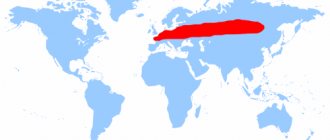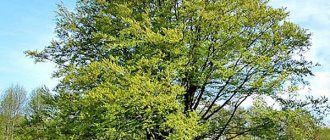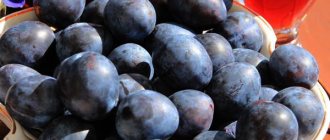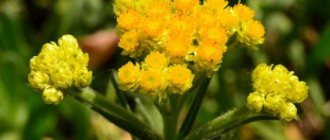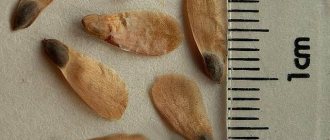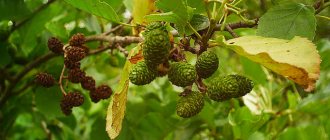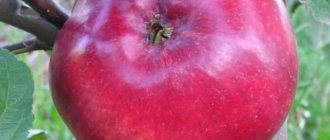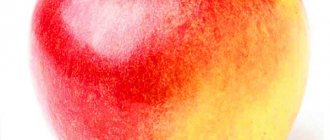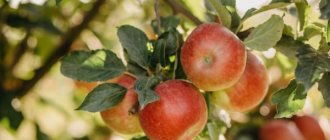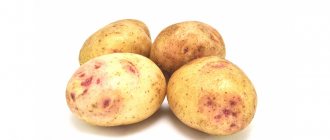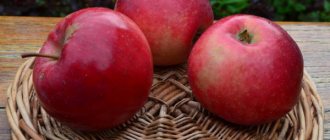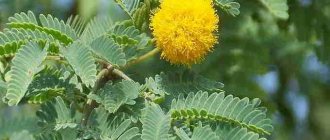Advantages
Unlike pine or spruce, larch sheds its needles. However, it has its advantages over evergreen conifers:
Larch branches
- Rapid growth. In favorable conditions, annual growth can be 1 meter.
- Resistance to frosts – including spring ones.
- Grows well even in problem areas. For example, with high groundwater levels, swampy areas, places where melt water stagnates.
- Not afraid of drafts.
- A large selection of varieties and hybrids allows you to choose a plant for any landscape design: park, arboretum, container.
- Compared to other conifers, it is much less often affected by diseases.
Siberian larch (Larix sibirica Ldb)
The strength of this tree is 30-60% higher than that of pine. It is the only conifer that sheds its green cover for the winter. It can stay in water for a long time, only becoming stronger and harder. All this is Siberian larch.
This is the most common tree species in Russia. Its reserve is equal to approximately one third of all wood growing on the territory of the Russian Federation (28 billion m3 out of 82 billion m3, respectively). The distribution area is the Urals, in Western and Eastern Siberia, where up to 95% of the total grows. However, pure larch forests are quite rare. Much more often the tree grows in mixed coniferous forests next to pines, cedars and spruces.
In Rus', larch has long been used to build houses. With the development of shipbuilding, it began to be used to build ships. Only until 1862, 500 military ships were built from it in Arkhangelsk. Such majestic buildings as St. Isaac's Cathedral and the Winter Palace stand on larch stilts. Today, larch boards are considered primarily as a finishing material in the mid-price category
Botanical description
The tree can grow up to 35-40 meters in height. This is a light-loving plant that literally “reaches out” to the sun all its life, feeding on its life-giving energy. It is famous for its ability to withstand severe frosts down to -65°.
The trunk diameter varies from 80 cm to 1 m. Relative to other parts, the volume of the trunk is 77-82%.
With age, the pyramidal crown loses its clear outline and grows widely. As it grows, the bark becomes covered with deep longitudinal cracks.
The soft needles are colored light green with a bluish bloom and are collected in bunches. It falls in the fall. This way the tree retains moisture during severe winter frosts. This property distinguishes the tree from others from the Coniferous order. It was thanks to him that the tree received its name in our country - larch. While in Europe it is called Larix - “richly resinous”.
It is a monoecious plant in which single male spikelets are pollinated in the spring by globular female spikelets, colored purple or pink. The fruit, a cone, contains about two dozen scales from which seeds fall out.
Features of wood
In terms of its biostability, Siberian larch is somewhat superior to its closest “relative” from Europe. Resistance to decay is almost 1.75 times higher than that of oak, and 2 times higher than that of pine.
The main structural element is tracheids, the size of which in early wood is 52.4 microns in early wood, and 21.8 microns in late wood. Of all the conifers, larches have the thickest tracheid walls, which also explains their increased strength.
This is a soundwood with a thin layer of sapwood, the thickness of which varies from 8 to mm. the size of annual rings can vary: from 0.4 to 2.2 mm and depends on the natural growing conditions. The finished lumber has a rich texture and warm, vibrant colors.
The volume of late wood in larch can reach 39%, which also has a positive effect on its physical and mechanical properties.
The average values of the operational characteristics of Siberian larch are as follows:
Density 660 kg/m3.
Compressive strength along the fibers is 61.5 MPa.
Bending strength 97.8 MPa.
Tensile strength along the fibers is 120 MPa.
Hardness 24.9 MPa.
Elastic modulus 14.9 MPa.
The quality of Siberian larch is determined by the technical conditions GOST 8486-86 and GOST 24454-80. A smaller number of knots than other conifers provides a greater yield of high-quality lumber.
Processing larch wood is associated with a number of difficulties, one of which is the high risk of tools becoming greasy. In addition, the material is characterized by low adhesion and gluing ability. This, as well as the large difference in the density of the core and sapwood and low vapor conductivity, cause the species to be less in demand on the market than pine.
Application of Siberian larch
Currently, larch is used primarily as a finishing material, in hydraulic structures and in the production of yachts, and also as a raw material for the production of laminated veneer materials.
High-quality floor coverings are made from it using heat treatment. Wood is very popular in the West, in Scandinavian countries in factory-made wooden housing construction.
Planting larch
When caring for larch, propagation is perhaps the most difficult stage of cultivation. You can buy a ready-made seedling or try to grow it from seeds. The seed is pre-soaked in water for 2 days. Any seeds that float to the surface are thrown away. Their quality leaves much to be desired. The good ones are sent to a separate container and mixed with moistened sand in a ratio of 1:3. Place in the refrigerator and keep for three weeks.
Coniferous forest
It is best to sow larch seeds in mid or late spring. To do this, the seed is immersed in the soil a centimeter, the recommended distance between the rows is 10 cm. A mixture of peat and sand (also 1:3) is poured on top and mulched. When the first shoots appear, the mulch is removed. Maintenance is simple and boils down to constant watering, weeding and thinning. Planting takes a lot of time, but then the tree begins to grow quickly. The fruits appear in the tenth year.
Cuttings
At first glance, it seems that propagating coniferous plants by cuttings is an elementary task. They cut the cuttings, planted them, and then it was up to Mother Nature. Although in reality you will have to work a little while following the rules.
- Larch propagation by cuttings begins by cutting branches 12 centimeters long from the tree. Then carefully inspect them for damage. There is no need to strip the bark, since replanting larch will be accompanied by a loss of beneficial microelements.
Larch cone
- A shallow cut is made in the middle of the bark. This will ensure contact with the soil mixture.
- Before planting, it is advisable to treat the cuttings with some kind of biostimulant. Kornevin has proven himself well. Next, the incision site is wrapped with film and moss so that the shoot does not freeze or dry out.
- Since larch grows quickly, it is immediately immersed in the soil mixture. This is another significant advantage - you can bypass the procedure of growing in containers and immediately plant the plant in open ground.
- Next, caring for larch comes down to moderate watering and waiting until the cuttings take root and become well established.
Planting larch seedlings
When planning to plant larch that is 2-3 years old, a hole for it is prepared in advance. The size depends on the seedling itself. Usually this is 50 x 50 cm, but if the tree was purchased in a container, the hole is increased to 100 x 100 cm. The tree is carefully placed in the hole to avoid damage to the root system. Cover the top with a mixture of peat and turf soil in a 1:1 ratio. It is important that the root collar is not covered with soil - it must remain on the surface. Heavy soil is diluted with sand, and drainage is required. Having placed the seedling in the ground, water it abundantly with water - 2 buckets will be enough.
Be careful when planting larch - you cannot touch the apical shoots. Even minor damage can affect the tree trunk and cause it to grow crooked. It will no longer be possible to correct the mistake.
Reproduction
Cuttings of this conifer have poor survival rate, so gardeners use the seed growing method.
Seed collection is carried out after the cones have fully ripened - in late autumn, but always before the onset of the first frost. You can also take purchased seed material.
Before planting, it is stratified in the refrigerator, having previously been mixed with sand in a 1:1 ratio. After 2 months of aging, the seeds are sown in a peat-sand mixture.
- For planting, you can use seedling boxes, or better yet, disposable, capacious containers with drainage holes to avoid further picking.
- When planting individually, 2-3 specimens are lowered into each hole to a depth of 3-4 cm; at best, one strong sprout will sprout from them.
- The seeds are sprinkled with a thin layer of sand, irrigated with water, and covered with halves of plastic bottles.
- Place in a room with high humidity (75%) and a stable temperature within 20-22°C.
Over the course of 1.5-2 months, they are periodically moistened, ventilated, and yellowed shoots and weeds are removed.
If strong sprouts have grown from three seeds, remove the cover and then plant them separately so that they can fully develop. As soon as they get stronger and grow, they are transferred to a cool place with a temperature of 17-19°C.
Transplantation to the site is carried out after 1.5 years of growing at home, when the seedlings have formed a massive root system and above-ground part.
Features of care
As you may have guessed, larches are not afraid of cold weather. In general, they are resistant to many vagaries of nature, including prolonged precipitation, frost, and wind. But there is one factor that the plant really fears, like fire. This is the summer drought. Experienced gardeners advise regularly watering both young shoots and mature trees. For example, in July, if there has been no rain for 10 or more days, it is recommended to pour 2 buckets of water under each specimen 1-2 times a week.
Only young trees need loosening; adults can be left alone. All weeds must be removed. They not only deprive the seedling of sunlight, but also drown it out.
Mulching
After planting seedlings or seeds, you need to cover the ground with mulch. It helps retain moisture, protects against cold, and prevents the development of weeds. Sawdust and straw, peat are used for the material. Already mature larches tolerate frost well and do not need additional protection. But it is better to wrap young trees in burlap. You can tie up individual branches or put a support so that they do not break under the weight of the snow.
Fertilizers
When the Japanese larch is planted, you can begin to apply complex fertilizing. The optimal solution would be the Kemira station wagon. For each square meter, apply 20 grams of fertilizer. To accelerate growth and development, fertilizers with potassium and magnesium are applied. In the summer, they water it with urea - for every ten liters, take 10 grams of the product.
Photo of larch
In general, you need to watch the tree. If the development of weeping larch is proceeding normally, there is no need to rush into feeding. Have you noticed that your appearance has deteriorated? It's time to support it with complex fertilizers.
Pruning, preparing for winter
For most species, winter does not pose much of a threat. The only exception is Japanese larch. If the snow has already melted, but the risk of frost remains, you can insulate the plant in the spring. For larch, pruning is not a mandatory procedure. However, it is still recommended to carry it out so that a beautiful crown is formed.
Types and varieties. Harvesting
The main difference between varieties is not only in the size and shape of the cones. For example, the Gmelin larch sheds its needles at the end of October, while the American and Siberian larch ends in November. Each species has dozens of varieties and subspecies, it’s impossible to list them all. The main ones include:
- Falling or European. Prefers mountainous areas and grows in many European countries. The most famous forms are Polish and Carpathian.
European larch
- Japanese or Kaempfer's larch is an endemic plant native to the island of Honshu in Japan. The species was adapted for cultivation in Europe and on the island of Sakhalin. Popular varieties: Blue Dwarf and Wolterdingen.
Kaempfer's larch
- Siberian. It grows over vast areas, including Altai, Siberia and part of China. It tolerates frost well and is suitable for growing in urban areas.
Siberian
- American. A rare visitor to Europe, mainly found in the USA (northeast) and Canada. It has a gorgeous crown and powerful, fluffy branches.
Harvesting is an art. It’s good that the cones hang low; sometimes you can do without a stepladder. The collected fruits are placed in a linen bag next to the battery. Under the influence of high temperature, the scales will bend and it will be possible to get the seeds. But the cones of European larch will have to be cut with pruning shears. The collected seeds are stored in paper bags.
Scope of application
The wood material of this coniferous representative can be used in many cases. Furniture, parquet, and decorative interior elements are made from raw materials of the first grade, while roofs and supporting structures are made from lower grades.
Proper finishing of wood will prepare it for flooring, roofs, fences, facade decorations, external cladding of buildings, and foundations for interior partitions. The resistance of dry boards to moisture and high temperatures and the preservation of all properties allows for interior finishing of baths.
The sun and precipitation do not destroy the ground coverings of this plant outside buildings, so its use on balconies, terraces, paths and gazebos is the best choice.
Common diseases
The common larch does not have many enemies among insects. But certain pests and diseases can still harm the plant. The first place in prevalence is occupied by larch cancer. Unfortunately, it is almost impossible to cure the tree, and in a short time it dies. In second place is fusarium, which mainly affects seedlings. It is easier to prevent a disease than to treat it if you treat the soil in advance with copper-containing products or potassium permanganate.
European larch branch
Another serious disease that affects decorative and weeping larch is called shutta. It can be identified by the red spots that appear on the needles in April-May. In the future, the disease leads to almost complete loss of needles. It is better to be proactive and spray the plant with a solution of colloidal sulfur or Bordeaux mixture in advance.
Larch in landscape design
The tree has a very wide range of applications, since in nature there are both huge trees and miniature decorative larch. Planted in group or single plantings, used to create hedges. It is noteworthy that it is friendly towards other plants and tolerates any neighborhood well.
By the way, about the neighbors. Landscape designers advise planting larch in the spring along with crops such as juniper, barberry, maple and birch. It also grows well with conifers. Dwarf species are planted in Japanese gardens; decorative varieties can be seen on the trunk.
Thanks to its luxurious appearance and attractive shape, the tree becomes indispensable for decorating parks, gardens and streets. The needles perfectly transmit the sun's rays; the plant does not create shadows for other crops. On the eve of winter, it sheds its needles, and this is what makes larch different from other conifers in the fall. Care in the autumn is much simpler and comes down to pruning shoots and adjusting the size. By the way, in Japan it is larch that is used to create bonsai. In spring, soft needles appear on the branches, which can be blue or light green. The tree's cones are unusual; they give the branches a special charm.
general characteristics
The name in Latin is larix sibirica. Siberian larch is a member of the Pine family, is the only representative of coniferous species, and sheds its leaves in the winter.
The culture is listed in the Red Book.
It grows in Western and Central Siberia, as well as in the North and East of the European part of Russia.
The zone of geographic speciation is the eastern territories, the distribution of populations is noted from the Urals to Lake Baikal.
Flowering occurs in the middle or end of May; after the end, elongated, purple cones are formed; closer to autumn they change color to pale yellow.
External description
The height of the tree in its natural environment can reach 40 m; in a cultivated form it is smaller in size - about 20 m.
The crown looks like a cone, thick, dense, and in adulthood takes on a spherical shape. Diameter - 1.5-1.7 m. The needles are green, soft, narrow-linear, collected in dense bunches of 40-45 pieces.
The bark on the central conductor is thick, gray-brown, and cracks in some places. Adjacent branches are short, gray-yellow, life expectancy is 10-12 years;
The buds are scaly and come in two colors - reddish or yellow-brown.
The root system is massive, taprooted with slight branching, and is resistant to strong winds.
Larch is very similar to the European species. The only difference is the color of the cones; at the beginning of spring they are bright red and shaped like roses. They remain on the tree for several years, giving it extremely high decorative value.
